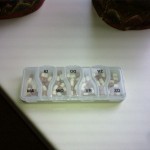You know, there’s this little device invented to help organize people’s pill popping. It’s a plastic oblong container divided into seven units, one labelled for each day of the week. A certain number of each kind of pill goes in each compartment, according  to a preordained plan, of course. It looks like this. At least it does in the Netherlands, where we go Mondag, Diensdag, Woensdag, and so forth.
to a preordained plan, of course. It looks like this. At least it does in the Netherlands, where we go Mondag, Diensdag, Woensdag, and so forth.
All I need right now is painkillers, i.e., opiates (which I like) and muscle relaxants, i.e., benzos (which I hate). My neck still hurts about three times more since the surgery than before. It’s a Christian country, the Netherlands, so maybe they perform surgery in order to maximize pain now, in order to minimize the bill you’re going to be presented with when you die. I think that’s called penance. But probably it’s not that complicated. Bodies don’t like being sliced and diced and they register their dissatisfaction in the clearest possible terms.
So painkillers it is. And what’s to prevent me from taking an extra one or two today, and ending up a couple shy later in the week? The answer is self-programming. And that’s what the little box helps me to do.
I wrote a post on self-programming a few months ago. Here it is. The reason I bring it back up now is because I think it’s such a brilliant idea. Our brains are built in such a way that we are highly attracted to immediate rewards — pleasures, relief of various sorts, winning an argument at the expense of someone else’s self-esteem, or at the expense of the guilt you’re  going to feel when you think about what a shitty, selfish thing that was to say. In general, present wants, needs, urges thoroughly trump wants and needs that can’t be cashed in till later. But the kicker is that we think we’re in the driver’s seat. We think our present actions are actually generated by the conscious intentions that preceded them. Psychological and neuroscientific research is pretty clear: they’re not. They’re mostly generated by habit, context (including cues), and biased thinking. So we keep up this mythology about deliberate intentions while coming in for a landing based on factors beyond our control. This common human dilemma is nowhere as clearly demonstrated as in addiction.
going to feel when you think about what a shitty, selfish thing that was to say. In general, present wants, needs, urges thoroughly trump wants and needs that can’t be cashed in till later. But the kicker is that we think we’re in the driver’s seat. We think our present actions are actually generated by the conscious intentions that preceded them. Psychological and neuroscientific research is pretty clear: they’re not. They’re mostly generated by habit, context (including cues), and biased thinking. So we keep up this mythology about deliberate intentions while coming in for a landing based on factors beyond our control. This common human dilemma is nowhere as clearly demonstrated as in addiction.
The solution: self-programming. The prefrontal cortex and it’s good buddy, the anterior cingulate, are beautifully designed for self-programming. That’s why these brain parts evolved over the last few  hundred million years. So that we don’t just act on impulse; we create plans in advance that will filter, constrain, and otherwise improve our behaviour so that it isn’t just driven by impulse. Long-range planning works pretty well. Short-range planning is usually a sham, a rationale, for what you’re in the process of doing anyway.
hundred million years. So that we don’t just act on impulse; we create plans in advance that will filter, constrain, and otherwise improve our behaviour so that it isn’t just driven by impulse. Long-range planning works pretty well. Short-range planning is usually a sham, a rationale, for what you’re in the process of doing anyway.
So here’s this dandy little device that not only facilitates long-rage planning but actually helps us learn it — a critical skill for those prone to addiction. Simply a box containing compartments that tell you what you may do (take) and what you may not do (take) based on long-range reasoning. I love it! And do you remember the post in which I reported on research showing that regions of the anterior cingulate cortex increase in grey matter volume (synaptic density — probably a good thing in these regions, especially since it got eroded during all those years of using) after you quit? In fact, GM volume rises in a pretty straight line over months of abstinence, crossing the baseline estimate at about 9-10 months. Here’s the source article. The authors conclude “that recovery involves distinct neurobiological processes rather than being a reversal of disease-related changes. Specifically, the results suggest that regions critical to behavioral control may be important to prolonged, successful, abstinence.” I’d be willing to bet that the regions showing increased grey matter volume are where the neural basis of self-programming is strengthened — through practice!
Of course, for many of us ex-addicts, many of those compartments, maybe all of those compartments, contain a big fat zero. (I mean for people on a full-abstinence program). But it’s not really a zero, because you fill up the compartments with other stuff. Is Friday night going to be a difficult time, being at a party with a glass of iced tea in your hand? Well then you fill that compartment with two hours of your currently favorite mini-series, or a visit to a dear friend, or a chapter from a book you love. And you leave early to get your dose. It’s your reward, decided on in advance. So you don’t have to think about what you will or won’t do on that  particular evening. It’s already programmed. You programmed it three weeks ago when you got the invitation. And now you’re free to enjoy or at least endure the party. You have a nicely evolved cortex and you’ve learned to use it well. Keep learning.
particular evening. It’s already programmed. You programmed it three weeks ago when you got the invitation. And now you’re free to enjoy or at least endure the party. You have a nicely evolved cortex and you’ve learned to use it well. Keep learning.
Here are a couple of Buddhistic-type figures smiling down on my new self-programming aid. They recognize that good planning is the route to nirvana.

Leave a Reply